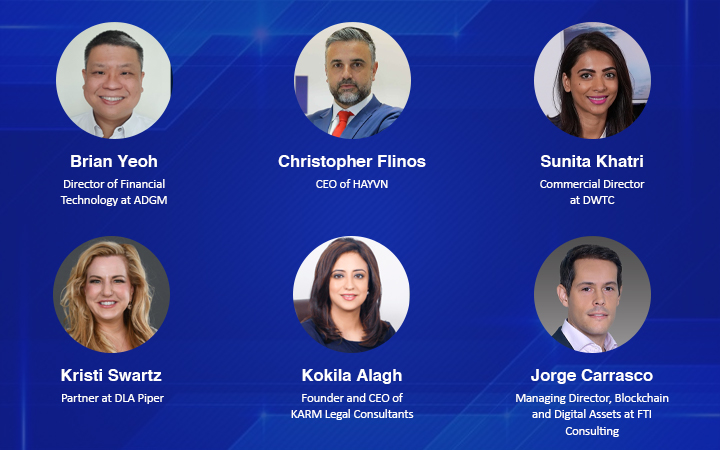Unveiling the Global Digital Assets Race: Insights from Experts on UAE, Europe, and Hong Kong’s Competition for Leadership

The United Arab Emirates (UAE) has long been recognized as a pioneering nation that consistently leads the way in innovation and technological advancement. In recent years, the UAE has demonstrated its commitment to staying at the forefront of the digital assets industry, solidifying its position as a global hub for companies operating in this transformative field.
Nevertheless, while the UAE has undeniably been a trailblazer in the digital assets space, it is important to note that it is no longer alone in this domain. Europe, for instance, has emerged as a formidable player with its own set of regulations aimed at fostering innovation while ensuring the stability and security of digital assets.
The Markets in Crypto-Assets Regulation (MiCA) framework, introduced by the European Union, has also laid down comprehensive rules to regulate the issuance, trading, and custody of cryptocurrencies and other digital assets. This proactive approach by Europe has further solidified the region’s position as a global hub for the digital assets industry.
Similarly, Hong Kong has joined the ranks of prominent global players in the digital assets sector. Recognizing the potential and importance of cryptocurrencies and blockchain technology, the government of Hong Kong has actively encouraged the growth of the industry. In a bold move, it has mandated that banks in the region provide services to crypto-related businesses and customers, thereby cementing Hong Kong’s status as a vibrant hub for digital assets.
As the UAE and other countries continue to forge ahead in the realm of digital assets, a compelling question emerges: Will the race to regulatory supremacy be marked by competitive obstacles posed by pioneering entities, or will it be a collective international endeavor to claim victory?
During an online round table organized by UNLOCK Blockchain, perspectives and opinions from industry leaders have provided valuable insights into the challenges and opportunities that lie ahead.

The UAE and ADGM’s Dynamic Regulatory Landscape for Virtual Assets
ADGM, an international financial center located in Abu Dhabi, has played a pivotal role in positioning the UAE as a global powerhouse in the digital assets realm. With its robust legal framework and business-friendly environment, ADGM has become a magnet for fintech and blockchain startups, venture capital firms, and established players seeking to capitalize on the potential of digital assets.
By providing a conducive ecosystem for innovation, ADGM has nurtured a thriving community of entrepreneurs and investors, driving the growth of the digital assets industry in the UAE.
However, Brian Yeoh, Director of Financial Technology at ADGM, faces the intricate challenge of navigating this complex regulatory landscape. He says that this is unavoidable given the remit of multiple regulators in the UAE, each with their own responsibilities and approaches.
The regulators involved include the Central Bank of the UAE (CBUAE), the Securities and Commodities Authority (SCA), the Financial Services Regulatory Authority (FSRA), the Dubai Financial Services Authority (DFSA), and the Virtual Asset Regulatory Authority (VARA).
The FSRA oversees virtual asset activities within the ADGM. It focuses on various areas of risk, including prudential risk, conduct risks, operational risks, money laundering/terrorist financing risks, and financial stability risks. Notably, the FSRA pays close attention to firms’ efforts to mitigate the specific risks associated with virtual assets. These include the need to manage the risks of potential market abuse, technology risks and protection of customer assets. Firms must demonstrate their ability to address money laundering and terrorist financing risks as well as disclose the specific risks associated with virtual assets.
When asked about the matter, Brian explained, “When it comes to regulatory changes, staying up to date is paramount. What was the right approach in 2018 may no longer be relevant in 2023. Regulatory bodies must continue to refine their frameworks by adhering to international standards, clarifying existing regulations, listening to industry feedback, and keeping pace with the evolving nature of virtual assets, including payment or staking activities.”
Kokila Alagh, Founder and CEO of KARM Legal Consultants, also acknowledges the UAE’s strong position in the realm of virtual assets. She praises the proactive approach taken by ADGM in 2018 when they initiated efforts to regulate the industry, even before blockchain and Bitcoin gained widespread recognition. This proactive stance is commendable and showcases the UAE’s commitment to innovation.
While other countries, including the UK, are grappling with regulatory frameworks for virtual assets, the UAE has positioned itself as a blockchain and crypto hub.
This positioning has attracted numerous companies seeking a crypto-friendly environment. According to Kokila, the UAE’s distinctiveness lies in its clear rules and regulations, enabling companies to operate within a defined framework without the fear of punitive actions often associated with regulatory implementations elsewhere, such as the approach of the US Securities and Exchange Commission (SEC).
Kokila commented, “The UAE’s pioneering efforts in regulating virtual assets and its commitment to fostering a crypto-friendly ecosystem have cemented its reputation as a leading destination for blockchain and cryptocurrency companies. The proactive and supportive regulatory environment sets the UAE apart and allows businesses to thrive within clear guidelines, which is what the industry needs and wants more than ever.”
Christopher Flinos, CEO of HAYVN, expressed his concerns regarding the challenges faced by businesses operating in the digital assets industry due to complex regulatory regimes.
He highlighted the difficulties faced by HAYVN in dealing with multiple regulatory bodies in the UAE, each with its own set of rules, which adds to the complexity of their operations.
Christopher noted that despite being regulated by ADGM, European banks were hesitant to onboard a UAE regulated entity while the UAE remains on the FATCA Grey list. Flinos anticipated that Saudi Arabia would soon introduce significant developments in the digital asset regulatory space.
Christopher emphasized the need for regulators to streamline the regulatory landscape, stating, “Undoubtedly, the entire ecosystem is experiencing growth, yet we earnestly desire regulators to find a solution that reduces the proliferation of multiple regulatory bodies. A unified regulatory framework would significantly simplify operations and alleviate the burdensome complexities faced by the crypto system as a whole.”
He further emphasized the importance of having a unified regulator and coordination with central banks and traditional financial regulators, to facilitate the operations of businesses in the digital assets industry.
On another note, Sunita Khatri, Commercial Director, DWTC, confirmed the increasing interest in the UAE, particularly from the gaming and DeFi sectors.
She said, “In the midst of complexity and crypto regulatory issues all over the word, the UAE continues to captivate, with companies eagerly venturing and showcasing their presence. Notably, the region has witnessed a remarkable surge of DeFi companies.”
With this in mind and amidst the race for regulatory dominance, where does Hong Kong stand with all the advancements that it has been pushing for? Are they really worth it or is it just racing to get in the game?
Hong Kong’s Virtual Asset Licensing Regime: An Overview
In Hong Kong, the regulatory bodies responsible for overseeing financial activities are the Hong Kong Securities and Futures Commission (SFC) and the Hong Kong Monetary Authority (HKMA). This regulatory structure differs from that of Singapore, which has a single regulator. The SFC has been designated as the regulator for virtual assets in Hong Kong, operating under the anti-money laundering and counter terrorist financing ordinance.
This led to the establishment of the VASP licensing regime known as the AMLO (Anti-Money Laundering and Counter Terrorist Financing Ordinance) VASP regime. The regime officially came into effect on June 1st of this year.
By implementing the virtual asset licensing regime, Hong Kong marked a significant milestone in the regulation of virtual asset trading platforms (VATPs). The Hong Kong Securities and Futures Commission (SFC) is responsible for overseeing this regime, aiming to position Hong Kong as a prominent virtual asset hub in the East. The SFC issued various regulatory guidance, including guidelines, FAQs, and handbooks, to assist operators of VATPs, known as Platform Operators, in complying with the new regulations.
Kristi Swartz, Partner at DLA Piper, has provided a detailed overview on Hong Kong’s virtual asset licensing, covering the licensing requirements, transitional provisions, product coverage, and the implications for banks.
Licensing Requirements and Transitional Period
Platform Operators actively marketing or operating in Hong Kong must apply for a Type 1 license for dealing in securities and a Type 7 VASP (Virtual Asset Service Provider) license from the SFC by February of the following year. VATPs seeking a VASP license are required to undergo two external assessment reports (EARs). The first focuses on evaluating the platform’s design effectiveness and readiness. While, the second assesses the implementation and effectiveness of policies, procedures, systems, and controls, after an approval-in-principle has been granted. The SFC’s satisfaction with the second-phase EAR is crucial for license approval.
From June 1, 2023, to May 31, 2024, existing VATPs operating in Hong Kong have a 12-month transitional period to comply with the AMLO VASP regime. These VATPs must submit their licensing applications by February 29, 2024, or cease operations by May 31, 2024.
Scope and Coverage under the AMLO VASP Regime
Centralized Custodial VATPs providing exchange services in Hong Kong or actively marketing their services to Hong Kong investors must be licensed and regulated by the SFC. However, VASPs that do not provide exchange services but solely offer custody services or act as virtual asset issuers are exempt from licensing requirements.
Licensed VATPs are required to have compensation arrangements approved by the SFC to cover potential losses. While “proof of reserves” is not mandatory, the compensation arrangement must exceed the total value of client VAs held in custody.
Under the AMLO VASP regime, virtual assets are broadly defined and encompass governance tokens of decentralized finance (DeFi) protocols with voting rights and potentially a wide range of non-fungible tokens (NFTs).
Limited Yet Welcoming: Hong Kong’s Positive Regulatory Shift
Licensed Virtual Asset Trading Platforms (VATPs) in Hong Kong are restricted to offering spot trading services, which may be perceived as less comprehensive and less exciting. While these limitations fall short of expectations, they are a significant improvement considering the historical stance of the previous chair of the Securities and Futures Commission (SFC) just two years ago, who adamantly opposed any involvement with cryptocurrencies. In the words of Kristi, “sometimes we take what we can get.” Despite its constraints, this approach has been warmly welcomed as a positive shift in regulatory attitude, even though it remains relatively restrictive.
Criticisms of the VASP Licensing Regime
The VASP licensing regime has faced criticism for adopting a product-based regulation approach, potentially causing complexities and uncertainties when products change. Moreover, while the regime eliminates the retail ban, it still imposes significant restrictions on the accessibility of certain virtual assets, such as stablecoins. This may hinder the desired goal of incentivizing retail investors to trade on SFC-regulated VATPs.
Efforts to Resolve Banking Challenges
Furthermore, the reluctance of banks to open bank accounts for crypto assets was seen as a hindrance to the regulatory efforts of the SCA in the HKMA. Even in cases where platform providers were involved in activities unrelated to crypto payments, essential transactions such as payments to developers were being denied.
To address these concerns and promote the integration of virtual assets into the economy, a meeting was organized by the government, HKMA, and SFC, bringing together 14 bank representatives. The aim was to discuss the current challenges and concerns faced by these institutions.
While banks have shown willingness to open operational accounts for crypto exchanges, there remains uncertainty and caution regarding client accounts. The requirement for segregated accounts in Hong Kong, as well as in the Middle East, adds complexity to the situation. The argument against not considering the opening of segregated accounts for players in need is deemed unfounded, as it is a crucial part of the Approval-in-Principle (AIP) process in Hong Kong. Upon receiving AIP, it is mandatory to have segregated accounts for both operations and clients. Consequently, there is a risk of progressing significantly in the process, only to discover the inability to obtain a bank account after nine months.
The outcome of the government meeting with banks was largely positive. Firstly, the fact that these institutions were brought together allowed for a fruitful discussion. Additionally, HKMA emphasized that banks were not required to perform due diligence on the clients of crypto exchanges, but rather on the exchanges themselves. This approach instills confidence in banks as licensed crypto exchanges and regulatory frameworks are established.
EU’s Markets in Crypto-Assets Regulation
Markets in Crypto-Assets (MiCA) is the European Union’s first regulatory framework for crypto-assets, aiming to position Europe as a leader in the crypto industry. It provides a comprehensive and clear set of rules for the issuance, trading, and custody of digital assets, covering various types of crypto-assets. Initially drafted in response to concerns over Facebook’s Libra/Diem project, MiCA addresses gaps in current EU financial services legislation and brings standardization to the crypto sector. The framework has garnered praise for its detailed approach and is expected to have a significant impact on the industry. It aligns with regulatory efforts in the Middle East and sets a precedent for future regional and local regulations.
Applicability to Crypto-assets and Market Participants
MiCA applies to all issuers, service providers, and market participants involved in crypto-assets in Europe. It extends beyond EU-registered firms to include firms marketing crypto to EU customers. Non-European crypto service providers may need MiCA authorization if they offer cross-border services into the EU.
All crypto-asset service providers must obtain authorization from their national competent authority before offering services in the EU. This includes issuers, custodians, exchanges, and intermediaries.
MiCA regulates primary market activities such as issuance/public offerings and access to the secondary market (listings). It also covers ten “crypto-asset services” based on the list of investment services in MiFID II. These services include custody and administration of crypto-assets on behalf of third parties and operating a trading platform.
Under MiCA, a crypto-asset is defined as any digital representation of value or rights that can be transferred and stored electronically using distributed ledger technology. There are three sub-categories: electronic money tokens (EMTs), asset-referenced tokens (ARTs), and a catch-all category for other crypto-assets, including non-pegged payment tokens and utility tokens.
MiCA designates significant ARTs and EMTs based on specific criteria and imposes stricter rules on their issuers, including capital requirements. The European Banking Authority will supervise them, similar to the classification of systemically important banks.
Exclusions and Liability Concerns
MiCA does not cover certain types of crypto-assets already regulated under existing financial services laws, such as security tokens under MiFID II. It also excludes unique crypto-assets like non-fungible tokens (NFTs) unless issued as part of a series or collection. Concerns arise regarding the broad liability of crypto custodians, which could lead to limited custodianship options or higher costs for EU investors.
MiCA acknowledges that truly decentralized arrangements and crypto-assets without identifiable issuers fall outside its scope. It does not capture Decentralized Finance (DeFi) and operations of Decentralized Autonomous Organizations (DAOs) as long as control is genuinely decentralized.
Contrasting Regulatory Approaches: UAE’s Flexibility vs. EU’s Uniformity and Hong Kong’s Transition
Various countries employ different approaches to regulate the crypto sector, each with its own advantages and disadvantages. From the competition for innovation in the UAE to the emphasis on security in Hong Kong and the principle-based approach in Europe, each approach reflects a distinct set of priorities and trade-offs.
Compared to the EU, the UAE is a small country with its own advantages. It can quickly create and implement regulations, allowing for flexibility and multiple iterations, according to Jorge Carrasco, Managing Director, Blockchain and Digital Assets at FTI Consulting. In contrast, Europe follows a principle-based regulatory approach, which makes it difficult to determine the exact implementation of regulations due to different approaches and frameworks among member countries. The advantage of MiCA, on the other hand, is that it establishes unified principles for everyone to follow. While the specific paths may vary, the end goal remains the same.
We have witnessed delays in the release of MiCA principles, and it will take time for them to come into effect. Furthermore, each country in the EU will likely adopt and mature at its own pace.
Jorge suggests that the UAE stands out for striking a good balance between protecting customer interests and promoting innovation by enabling licensing for various activities and adopting a more open approach to regulation, outside of rigid rule books. Abu Dhabi and Dubai have implemented sandboxes to facilitate this process.
Kristi notes that the UAE has shifted its stance and intends to establish a lasting presence rather than being a transient hub. Hong Kong went through a similar transition and is expected to develop its regulations further. While Hong Kong’s current regulations may not be appealing and are relatively restrictive, more developments are anticipated. Hong Kong regulators initially focused on regulating exchanges, as it was the easiest entry point and covered most activities in the space, says Kristi.
Global Regulatory Landscape for Virtual Asset Businesses: Perspectives and Challenges
The global regulatory landscape for virtual asset businesses is a complex and evolving terrain, encompassing various approaches and perspectives across different countries and regions.
With the rise of cryptocurrencies and blockchain technology, governments and regulatory bodies worldwide are grappling with the task of effectively managing this new digital ecosystem. As virtual asset businesses strive to navigate this landscape, understanding the nuances and challenges of the regulatory environment becomes crucial for their long-term success and growth.
The Demand for Universal Principle-Based Guidelines and the Lack of Global Coordination
Jorge notes that there is a global demand for general, principle-based guidelines that can be applied universally, easing the operations of virtual asset businesses. According to him, a principle-based approach to crypto regulations is crucial. Currently, there is no global entity outlining comprehensive guidelines for regulators worldwide, leading to a lack of international dialogue and coordination. Even at the regional and country levels, internal coordination among financial regulators, central banks and banks is minimal, hindering smoother operations for companies. Banks and other stakeholders are still in a state of precaution, avoiding first mover challenges, argues Jorge. Thus, companies must carefully assess compliance relative to governance best practices and various global regulations that are available.
Collaboration among international bodies like IOSCO, the World Economic Forum, or the Bank for International Settlements is vital to define a minimum viable product for the industry. This collaboration can facilitate the concept of “passportability,” allowing regulated entities to operate across jurisdictions with light-touch regulation, based on shared standards, suggests Kristi.
In the same vein, Kokila emphasizes the need for an international body that takes a holistic view of regulations without delving into intricate details. Such an entity would ensure that regulatory recognition or passporting is respected across jurisdictions, highlighting the importance of global collaboration.
Exploring Feasibility: Global Passporting vs. Meeting Jurisdiction-Specific Requirements
Brian had a different perspective, noting that passporting arrangements are still not common even in traditional financial services. For example, firms in the UK no longer enjoy direct passporting arrangements into the EU, even if they had had such arrangements prior to 2016. In this regard, while virtual asset firms are understandably frustrated by the challenges of dealing with each jurisdiction’s regulatory requirements, lobbying for passporting arrangements is unlikely to bear fruit in the near term.
Instead, firms should focus on demonstrating a clear track record of compliance in each of the jurisdictions they operate in, which would provide greater assurance when approaching regulators in other jurisdictions. Indeed in this regard, firms that operate in a jurisdiction with high standards of regulation, as ADGM seeks to uphold, may face fewer difficulties when engaging with other jurisdictions. In contrast, firms which are not held to an equivalent standard may face challenges when adapting to jurisdictions with stringent requirements.
Ensuring Effective Segmentation and Selectivity in Regulating Digital Asset Firms
Brian adds that segmentation within the digital asset space is another critical aspect to consider, as it encompasses various types of assets, such as traditional digital assets (e.g., tokenized T-bills), virtual assets (e.g., cryptocurrencies), and more specialized offerings like NFTs, GameFi, and DeFi. Defining the target digital asset firms, sequencing their entry, and establishing mechanisms to exclude undesirable institutions are vital considerations, similar to the approach taken in Hong Kong.
Kristi believes that having reputable players and participants is essential. While regulation is necessary and universally understood, Hong Kong’s successful ICO phase can be attributed to self-regulation and the presence of knowledgeable advisors who exercised caution according to Kristi. Identifying and deterring bad actors who present initially plausible plans but have questionable track records and activities is an ongoing challenge for regulators. Risk appetite and clear identification of the desired types of firms to support are essential factors in this process, suggest Brian. Therefore, it is crucial to focus not only on attracting digital asset firms but also on selecting the specific digital asset firms for attraction.
In conclusion, the UAE has established itself as a leading nation in the digital assets industry, showcasing its commitment to innovation and technological advancement. Through the implementation of forward-thinking regulations, spearheaded by visionary regulatory authorities, the UAE has created a solid foundation for the industry and positioned itself as a global hub for digital assets companies.
However, it is important to acknowledge that the UAE is no longer alone in this domain. Europe, with its Markets in Crypto-Assets Regulation (MiCA) framework, and Hong Kong, with its supportive measures for the industry, have emerged as formidable players in the global digital assets sector. They have also solidified their positions as vibrant hubs for digital assets, emphasizing the need for collaborative efforts among nations.
As the UAE and other rival countries such as Singapore, continue to navigate the evolving landscape of digital assets, the question arises as to whether the race to regulatory supremacy will be characterized by competitive obstacles posed by pioneering entities or if it will be a collective international endeavor to claim victory.
The future of the digital assets industry will depend on the ability of nations to strike a balance between fostering innovation and ensuring stability and security, while also promoting collaboration and knowledge sharing among global players.
However, the ability to convene diverse parties and entities at a single table to discuss the future of this industry is an extremely positive indication that we are proud of.





